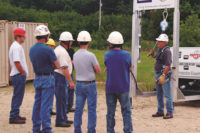There’s really very little difference between these two situations. If you allow either, you are putting someone at risk for whose safety you are responsible. But in the case of personnel working at heights, not only are you putting lives at risk, you’re breaking the law. OSHA 1926.503(a)(1) states, “The employer shall provide a training program for each employee who might be exposed to fall hazards. The program shall enable each employee to recognize the hazards of falling and shall train each employee in the procedures to be followed in order to minimize these hazards. When working at heights, fall protection training is necessary.”
Identify what works
Although training is required by law, not all training programs are created equal. An effective fall protection training program is easy to identify if you know what to look for. The following are five best practices for comprehensive training:
1. Start with an explanation of the hazards:One of the biggest mistakes in fall protection training in the United States is discussing fall-arrest equipment at the start of the course. Although this is an important part of the program, it is not the best place to begin. Trainees need to understand three concepts before discussing how to use fall protection equipment. These concepts are:
- The reasons why fall protection equipment is necessary
- Specific fall hazards, such as swing falls, and the forces generated in falls
- The clearance necessary in the event of a fall
2. Accommodate the adult learner:Since adults learn by reading, watching and doing, the most effective way to train adult learners is through hands-on training and live demonstrations supplemented by classroom instruction. In fact, under ANSI or OSHA, using videos alone to teach fall protection simply does not cut it. According to an OSHA letter of interpretation, fall protection training should, as realistically as possible, simulate on-site conditions. This means that fall protection courses must incorporate hands-on training.
3. Use a professional trainer:While this may seem like an obvious point, not all trainers are dedicated to training and may not be experts in the field. When a trainer cites an OSHA regulation, he or she should be able to explain how it applies. For example, OSHA says that two snap hooks cannot be connected to one D-ring; can the instructor explain why? Does the trainer know that not everything on the harness is rated up to 5,000 pounds? (It’s true—the buckles on the harness are rated for 4,000 pounds.)
4. Look for an ANSI Z359.2 compliant program:Make sure your fall protection training complies with the ANSI Z359.2 standard, “Minimum Requirements for a Comprehensive Managed Fall Protection Program.” This standard outlines the learning objectives for an authorized user, competent person, competent trainer, qualified person and qualified trainer. By law, OSHA requires the competent person trainers to be deemed a competent person in order to teach a class. An ANSI competent person trainer must not only be trained as a competent person, but also be capable of teaching adults. Some trainers may be experts in the field but may lack the adult education skills to teach effectively. Under ANSI, the trainer must have lesson plans, learning objectives and adult education skills.
5. Don’t rely on a slideshow:Anyone teaching safety in an adult education environment will insult the intelligence of trainees by reading slides rather than using them as reference tools. When trainees ask a question, the trainer should have heard that question before and be able to address it during the course. More interaction between the instructor and trainees will lead to a more engaging course that is truly valuable to workers’ day-to-day concerns.
Additional training thoughts
Fall-protection training should be conducted whenever a new employee is brought on board. Following that, periodic assessments should be provided at least annually by a competent trainer. ANSI recommends refresher training every two years at a minimum; OSHA requires refresher training if the workplace changes, new systems or equipment are issued, or if a worker doesn’t display adequate knowledge. A written evaluation and skills demonstration should be performed to ensure that employees are knowledgeable in all types of fall protection equipment they are authorized to operate.
Even the toughest and riskiest situations can become safe work environments with proper personal protective equipment and training. Failure to provide either of these creates a risk of injury and potential fines and also constitutes non-compliance with applicable regulations. Lost time, increased insurance premiums and lawsuits are just some of the costs that may result from a workplace fall.
Ultimately, the training you provide employees who work at height is just as important as the driver’s training offered to teenagers before they get behind the wheel. Without it, people’s lives are placed at unnecessary risk.
